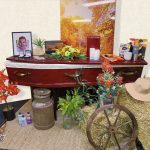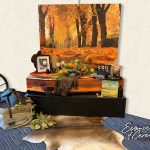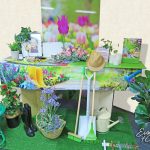Essence of Ceremony is a new way of presenting coffins and caskets that helps show the value of the funeral experience.
It is designed to provide inspiration, information and context to your families several days before the funeral.
Using the 13 elements embedded in the display, guided by the funeral director, families discover what is meaningful to them. They then incorporate these elements into a personalised tribute for their loved one.
Essence of Ceremony is in action, working in funeral homes now. Call us today to discuss how we can assist testing EOC in your funeral home.
Images of Essence of Ceremony displays (click to expand)…
13 Essence of Ceremony elements
Coffin/casket
- A coffin (or casket) is the vessel that carries the body.
- The ultimate symbol of death.
- Spending time choosing a coffin that reflects your loved one and then creating a ceremony around it can be a comforting and useful process.
- A coffin offers physical acts: carrying in and out of the ceremony, and lowering into the grave.
- Coffins can be wrapped in images on the outside and now a range of interiors that offer warmth and touch are available.
Flowers
- Flowers are a visual expression of our love, our sympathy and our grief.
- Flowers bring colour, freshness and fragrance to a funeral.
- Favourite colours and special flowers can be used in a casket display, in the venue welcoming people, or a single bloom placed on the coffin.
- Close friends and family may wish to show their support and caring by bringing or sending flowers especially if they are unable to attend.
Candles
- The ritual of lighting a candle to pay tribute to a life past has long been a part of funeral ceremony.
- Light a candle to begin the funeral.
- Have more than one candle.
- Having a burning candle signifies that the memory lives on.
- Extinguish the candle to end the ceremony and keep it to relight in the days that follow.
Photos
- A photo frame with a picture of the deceased leaves no doubt who the service is for and who lies in the coffin.
- Photos capture memories and significant life events.
- This is a visual connection and may include and engage the people attending.
- A photo tribute playing during the ceremony is a visual representation of someone’s life.
- It portrays so much without words.
Fabric/drapery
- Soft fabric is used inside the coffin.
- This is an opportunity to consider spending time with your loved one, alone or with family and friends in support.
- Your loved one could go home, to a place of worship or stay at the funeral home.
- Seeing and touching, being near the your loved one can allow you to process the reality of death and help express your feelings.
Ashes urn
- If cremation is the choice for final disposition, an ashes urn is something to hold your loved one’s ashes in.
- Whether it’s for display or interment, there is a variety of different urns and materials available.
Memorial book
- A memorial book offers you the opportunity to record your funeral day.
- Include photos, letters, a service sheet and signatures.
- Copies can be sent to those who are not there.
- In the days that follow, having a reminder of the day can be a source of comfort.
Personal items
- Personal items representing the interests and passions of the deceased is where families can really make the funeral a very relevant and personal time.
- Use signature items that people recognize and connect with.
- Items that tell the story of achievements in their life’s journey.
- Also allowing other people to contribute items and show long-forgotten treasures.
Embalming fluid
- The purpose of embalming is for preservation, presentation and sanitation.
- The purpose of embalming offers you time.
- Time for people to attend, time for you to adjust to the reality of death.
Words
- Words connect at the funeral ceremony.
- The telling of someone’s life story allows the moment of remembering, cherishing.
- And so triggering memories and allowing everybody to share and tell.
- Words can come from the Bible, poetry, a verse from spiritual sources, favourite books, letters and prayers.
Music
- Music has a way of touching us profoundly.
- We listen to music at funerals to set the mood and connect with the congregation.
- Music can be a very personal choice.
- Music can be an action, singing, and playing at a funeral. It can be a tribute or a gift.
- Music offers so much opportunity to personalise your event.
Remembrance Jewellery
- Jewellery can contain a portion of ashes to keep your loved one close, and allows you to express creativity and morning in a personal manner.
- A portion of ashes can be stored in additional jewellery and divided up between loved ones.
Tea cup or coffee mug
- A gathering can be arranged before or after the funeral, where food and drinks can be served.
- This allows you to spend some time with loved ones and friends that you may not have had time to speak to at the funeral.






